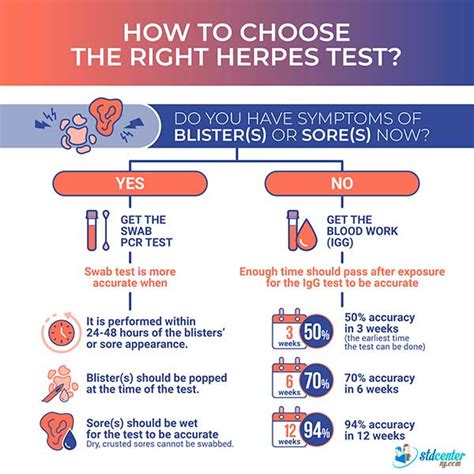Intro
Discover accurate Herpes Testing Methods, including PCR, serology, and viral culture, to diagnose HSV-1 and HSV-2 infections, and learn about symptoms, treatment, and prevention strategies for effective herpes management.
The importance of herpes testing cannot be overstated, as it is a crucial step in diagnosing and managing the condition. Herpes, a viral infection caused by the herpes simplex virus (HSV), can have severe consequences if left untreated. With millions of people worldwide infected with HSV, it is essential to understand the various testing methods available to diagnose and monitor the condition. In this article, we will delve into the different herpes testing methods, their benefits, and limitations, as well as the significance of early detection and treatment.
Herpes testing is vital for individuals who are experiencing symptoms or have been exposed to the virus. The testing methods can help determine whether an individual has HSV-1 or HSV-2, which is essential for developing an effective treatment plan. Moreover, herpes testing can also help prevent the transmission of the virus to others, reducing the risk of outbreaks and complications. With the advancement of medical technology, various testing methods have been developed to diagnose herpes, each with its own advantages and disadvantages.
The diagnosis of herpes can be challenging, as the symptoms may be similar to those of other conditions. Therefore, it is essential to consult a healthcare professional if symptoms persist or worsen over time. A comprehensive diagnosis may involve a physical examination, medical history, and laboratory tests. The testing methods can be broadly categorized into two types: virological and serological tests. Virological tests detect the presence of the virus, while serological tests detect the antibodies produced in response to the infection.
Types of Herpes Testing Methods

There are several types of herpes testing methods, each with its own advantages and limitations. The most common types of tests include:
- Polymerase Chain Reaction (PCR) test: This test detects the genetic material of the virus and is highly sensitive and specific.
- Culture test: This test involves taking a sample from the affected area and growing the virus in a laboratory.
- Serological tests: These tests detect the antibodies produced in response to the infection and can help determine whether an individual has HSV-1 or HSV-2.
- Rapid diagnostic tests: These tests provide quick results and are often used in clinical settings.
Virological Tests
Virological tests are used to detect the presence of the virus and can provide rapid results. The most common types of virological tests include:- PCR test: This test is highly sensitive and specific, making it an ideal choice for diagnosing herpes.
- Culture test: This test involves taking a sample from the affected area and growing the virus in a laboratory.
- Antigen detection test: This test detects the proteins produced by the virus and can provide rapid results.
Benefits and Limitations of Herpes Testing Methods

Each testing method has its own benefits and limitations. For example:
- PCR test: Highly sensitive and specific, but may not detect the virus in all cases.
- Culture test: Can provide a definitive diagnosis, but may take several days to produce results.
- Serological tests: Can help determine whether an individual has HSV-1 or HSV-2, but may not detect the virus in all cases.
Importance of Early Detection and Treatment
Early detection and treatment of herpes are crucial to prevent complications and reduce the risk of transmission. If left untreated, herpes can lead to severe consequences, including:- Neonatal herpes: A life-threatening condition that can occur when an infected mother passes the virus to her newborn.
- Encephalitis: A rare but potentially life-threatening condition that can occur when the virus infects the brain.
- Meningitis: A condition that can occur when the virus infects the membranes surrounding the brain and spinal cord.
Practical Applications of Herpes Testing Methods

Herpes testing methods have several practical applications, including:
- Diagnosis: Herpes testing methods can help diagnose the condition and determine whether an individual has HSV-1 or HSV-2.
- Treatment: Herpes testing methods can help monitor the effectiveness of treatment and adjust the treatment plan as needed.
- Prevention: Herpes testing methods can help prevent the transmission of the virus to others, reducing the risk of outbreaks and complications.
Statistical Data on Herpes Prevalence
According to the World Health Organization (WHO), an estimated 67% of people under the age of 50 worldwide have HSV-1, while 11% have HSV-2. In the United States, the Centers for Disease Control and Prevention (CDC) estimates that approximately 1 in 6 people aged 14 to 49 have genital herpes.Future Directions in Herpes Testing Methods

The field of herpes testing is constantly evolving, with new technologies and methods being developed to improve diagnosis and treatment. Some potential future directions include:
- Point-of-care tests: Rapid diagnostic tests that can provide results in minutes, making them ideal for clinical settings.
- Molecular tests: Tests that detect the genetic material of the virus, providing highly sensitive and specific results.
- Vaccine development: Research into the development of vaccines to prevent herpes infection.
Challenges and Limitations of Herpes Testing Methods
Despite the advancements in herpes testing methods, there are still several challenges and limitations, including:- Sensitivity and specificity: Some tests may not detect the virus in all cases, or may produce false-positive results.
- Availability and accessibility: Herpes testing methods may not be widely available or accessible, particularly in resource-limited settings.
- Cost: Some tests may be expensive, making them inaccessible to individuals who cannot afford them.
Conclusion and Final Thoughts

In conclusion, herpes testing methods play a crucial role in diagnosing and managing the condition. With various testing methods available, it is essential to understand the benefits and limitations of each test to develop an effective treatment plan. Early detection and treatment are vital to prevent complications and reduce the risk of transmission. As research continues to advance, new technologies and methods are being developed to improve diagnosis and treatment.
We invite you to share your thoughts and experiences with herpes testing methods. Have you or someone you know been diagnosed with herpes? What testing method was used, and what was the outcome? Share your story in the comments below, and let's work together to raise awareness and promote education about herpes testing methods.
What are the most common types of herpes testing methods?
+The most common types of herpes testing methods include PCR test, culture test, serological tests, and rapid diagnostic tests.
What is the importance of early detection and treatment of herpes?
+Early detection and treatment of herpes are crucial to prevent complications and reduce the risk of transmission. If left untreated, herpes can lead to severe consequences, including neonatal herpes, encephalitis, and meningitis.
What are the future directions in herpes testing methods?
+The field of herpes testing is constantly evolving, with new technologies and methods being developed to improve diagnosis and treatment. Some potential future directions include point-of-care tests, molecular tests, and vaccine development.
